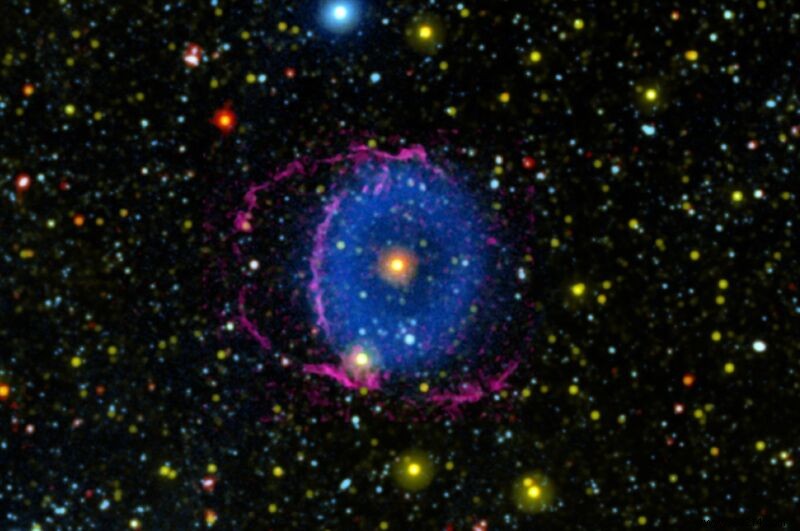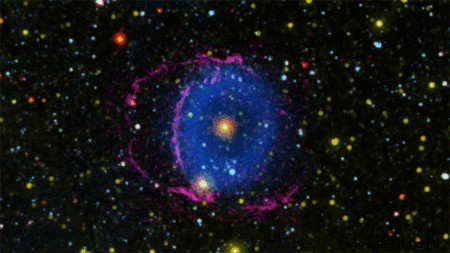For sixteen long years, the "Blue Ring Nebula" baffled astronomers trying to piece together its origin story. The mystery is finally solved. The structure would be the result of the fusion of two stars produced only thousands of years ago.
The Blue Ring Nebula was first spotted in 2004 by the Galaxy Evolution Explorer (GALEX), a telescope designed to probe the sky in the ultraviolet. At the time, the object looked nothing like anything scientists had seen before. It indeed appeared as a gigantic ball of incandescent gas with a star in its center. Note that if the structure appears blue to us, in reality it does not emit any color visible to the human eye. Its invisible ultraviolet light was simply "coded" blue by the telescope images.
Initially, astronomers speculated that this "blue ring", found 6,300 light-years away in the constellation of Hercules, could be the afterglow of a supernova explosion. However, this nebula offers a living star in its center. Additionally, supernova remnants radiate in several light wavelengths outside of the UV range. However, that was not the case here. The structure only radiates in the UV. So we had to look elsewhere.
To try to find out more, in 2006, researchers from the Carnegie Institution for Science and a member of the GALEX team at Caltech observed the nebula using two powerful telescopes:the Hale telescope at the Palomar observatory (California) and the WM Keck observatory in Hawaii. This work revealed that the gas making up the nebula had been expelled following a shock wave. From then on, we knew that a violent event had occurred on the spot , but what event? The mystery persisted.

More recently, the team relied on four space telescopes and four ground-based telescopes to gather new data. They also looked at historical observations of the star dating back to 1895, to isolate any changes in its brightness. Armed with this huge wealth of information, they were finally able to solve this mystery.
Researchers have indeed discovered evidence to suggest that the Blue Ring Nebula was in factthe result of the merger between two stars. One was about the same size as our sun and the other about a tenth the size.
How did this happen? A few thousand years ago, near the end of its life cycle, the star similar in size to the sun began to swell. In doing so, it moved closer to a smaller, nearby star. Due to the gravitational tug of the larger star, the smaller one eventually 'spiraled' towards the larger companion, before being 'swallowed up' entirely. Meanwhile, a disk of debris had formed around the large star.
Their merger then unleashed a cloud of hot debris, emitted into space and bisected by the gas disc in the middle. As a result, two cone-shaped clouds formed, moving in opposite directions, one of which was heading towards Earth as shown below:

While merged star systems are fairly common, they are nearly impossible to study immediately after they form, as they are obscured by the debris the collision triggers. Once the debris is cleared (at least hundreds of thousands of years later), they are also difficult to identify as they eventually look like single stars.
The Blue Ring Nebula thus presents itself as the "missing link". Astronomers have indeed found the presence of this stellar system just a few thousand years after the merger . The clouds of debris were therefore scattered enough to isolate the presence of the star resulting from this union and at the same time still close enough to be able to notice them.